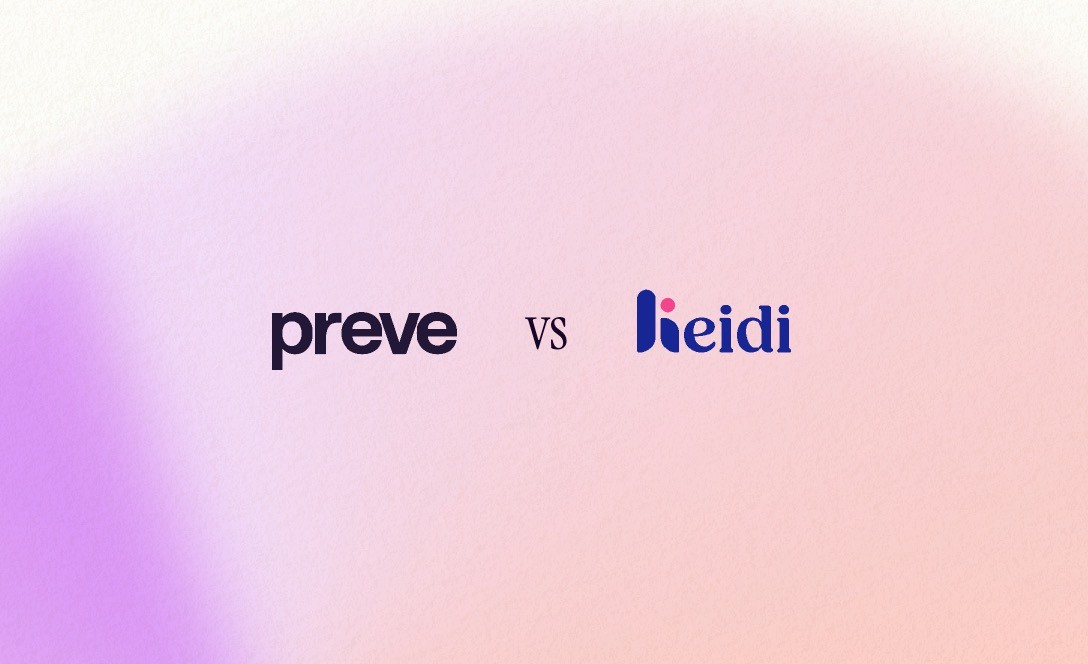preve vs heidi which ai tool really works for physiotherapists


Caelum Trott from PREVE
October 1, 2025
Heidi vs. Preve: Which AI Tool Really Works for Physiotherapists?
AI documentation tools are becoming commonplace in healthcare. Heidi has built a reputation as a strong, generalist medical scribe that supports doctors, nurses, and allied health alike.
But Preve is different. It isn’t just a scribe. It uses scribe functionality as a foundation to capture rich patient context - ****and then turns that into a complete experience for both physio and patient.
Here’s how they compare.
1. Specialist Origins & Design
Heidi is a general-purpose medical scribe, serving GPs, specialists, and allied health providers. It’s flexible, adaptable, and integrates well across disciplines.
Preve is built by physiotherapists, for physiotherapists. The workflows, templates, and outputs are all grounded in the realities of multi-session rehab, outcome tracking, and patient adherence.
Takeaway*:* Physio care isn’t a one-off prescription - it’s a journey. Preve is built for that journey.
2. Ongoing Session Context
Heidi focuses on accurate, efficient documentation of individual consults - strong in isolation.
Preve captures notes via scribe functionality but then remembers your patients and their previous sessions. This continuity means every future plan or checklist is context-rich.
Takeaway: For physios, that longitudinal memory is a game-changer.
3. Templates: Customisable vs. Ready-Made
Heidi allows you to build your own custom templates. That’s powerful if you want flexibility.
Preve comes with pre-set templates across physiotherapy specialty areas (MSK, hand therapy, women’s health, respiratory, etc). No setup, no tinkering, just plug-and-play.
Takeaway: Customisation is a great feature in Heidi, whilst Preve shines with it’s immediate physio-specific structures.
4. Post-Session To-Dos vs. Pre-Session Insight
Heidi generates a post-session to-do list, helping with follow-ups and documentation tasks.
With Preve, every consult starts with a pre-session checklist. Pulled from previous sessions, it surfaces the key details you need before the patient walks in.
Takeaway: Both are helpful, but for physios managing long-term cases, being prepped before the session makes the bigger difference.
5. Patient Experience: The Real Differentiator
Heidi, while excellent at clinician documentation, doesn’t provide this end-to-end patient experience.
This is where Preve steps beyond “scribe” and into something transformational.
Preve auto-generates a treatment plan for patients:
Plain-language diagnosis and causes
Personalised goals
Exercise prescriptions with videos and cues
Outcome measures
Milestones and timelines
Appointment schedule
Historical summaries
All of this lives in a patient-facing portal. Patients can check their plan anytime, track their progress, and understand what’s coming next.
Takeaway: Preve isn’t just saving physios time - it’s actively improving adherence, reducing cancellations, and delivering better clinical outcomes.
6. Saving Time vs. Driving Outcomes
Heidi is excellent at reducing admin burden for a wide range of healthcare professionals.
Preve reduces admin and drives patient engagement - creating a feedback loop where both clinician and patient get more out of every consult.
Takeaway: If you’re just looking for automated notes and documents, Heidi does a good job of this. If you’re looking for that plus better patient engagement and outcomes, you will prefer Preve.
PMS Integration
Heidi integrates with a wide range of medical practice management systems and EMR’s. In allied health, it integrates with Cliniko, Nookal and Halaxy.
Preve integrates with Cliniko and Nookal, meaning you can view your appointments and patients, with clinical notes being pushed back into the PMS. This means you can run your whole day from Preve. Preve also pulls historical patient context into the platform, meaning your past notes in Cliniko are considered in future sessions on Preve, creating greater continuity of care.
Takeaway: Both Preve and Heidi integrate with Cliniko and Nookal, with Preve having deeper integration capabilities (like historical context). But if you’re a Halaxy user and just need documentation generated then Heidi might be a better fit.
Final Verdict
Heidi is a powerful, well-designed scribe that works across multiple specialties. It’s an excellent choice if your primary need is faster note-taking across different clinical contexts.
But Preve is not just a scribe. It’s a physiotherapy-specific platform that uses scribing as a foundation to deliver something far greater:
Rich continuity between sessions
Profession-specific templates
Pre-session insights
Patient-facing treatment plans and portals
For physiotherapists, that means Preve isn’t just saving time — it’s transforming both your workflow and your patients’ experience of rehab.
Quick Comparison Table
Feature | Heidi | Preve |
|---|---|---|
Specialist Design | General-purpose medical scribe | Built by physiotherapists, for physiotherapists |
Core Role | Documentation and note-taking | Admin automation + patient engagement platform |
Session Continuity | Focuses on individual consults | Remembers prior sessions for ongoing context |
Template Options | Fully customisable templates | Pre-set physio specialty templates |
Session Prep | Post-session to-do list | Pre-session checklist |
Patient Experience | Clinician-focused documentation | Portal with goals, plans, milestones, outcomes |
Outcome Impact | Saves time | Saves time and improves adherence/outcomes |
Best For | Multi-specialty clinicians needing flexibility | Physios managing multi-session rehab journeys |
